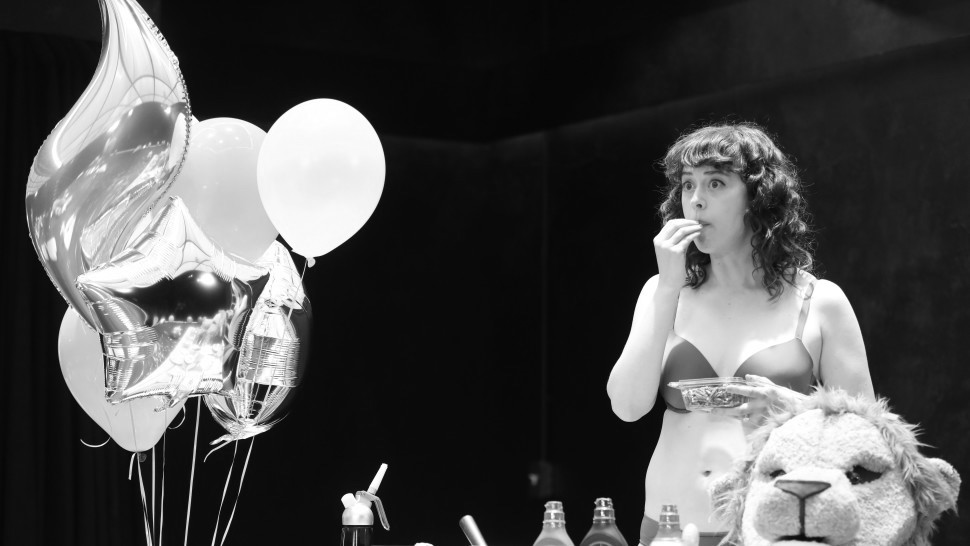There's A Betty In All Of Us

A few weeks ago I had the enormous pleasure of seeing Jen Silverman’s “Collective Rage: A Play in 5 Betties” at MCC. It’s a weird, hilarious, and absurd comedy that explores sexuality, gender, and theatricality. The premise is very simple but also wonderfully bizarre: the lives of five women, all named Betty, interconnect and transform in surprising and funny ways that all have to do with pussy. I don’t want to copy exactly what the New York Times says about the play, but Jesse Green does sum it up best by saying it’s like The Vagina Monologues times five. Actually, it reminds me of both that AND something from the mind of Taylor Mac. It’s feminist, queer as hell, and immensely entertaining. It’s perfect theatre for now.
The five Betties are all wonderful and fleshed-out characters that I all immediately wanted to be pals with. Betty 1 (Dana Delany) is a rich housewife so fed up with her philandering husband Richard she just needs something to hit; Betty 2 (Adina Verson from Indecent) is repressed and awkward, and just wants some friends who she can relate to besides her hand puppet; Betty 3 (Ana Villafañe from On Your Feet!) is a “high femme, super queer” bisexual Latina who dreams of stardom; Betty 4 (Lea DeLaria from Orange is the New Black) is supremely butch, works on trucks all day, pines for Betty 3 and tries to always say what’s on her mind; and Betty 5 (Chaunte Wayans) is a gender non-conforming, masculine-presenting, femme-bodied individual who uses female pronouns and works on trucks and runs a boxing studio.
Betty 3, struck by a play she thinks is called “Summer’s Midnight Dream,” decides she wants to write her own version of the play-within-a-play and recruits the other Betties to perform in it. The resulting collective chaos that ensues is funny, wild, and heartwarming by the end. It’s a wild ride that I don’t want to spoil all the way, but it involves Betty 1 and Betty 5 punching things and dressing up as Richard, Betty 2 becoming obsessed with both lions and her own pussy, and Betties 3 and 4 figuring out what exactly their relationship is.
Every actress plays their Betty so vividly, it’s hard to separate the real world actresses from their characters. These Betties feel lived in, like old friends who we’re checking in on at play rehearsal. It was great to see such a diverse array of shapes, sizes, sexualities, ethnicities and gender presentation on stage. I felt like I could relate to each Betty in some way – Betty 1’s hunger to just destroy the patriarchy, Betty 5’s proud androgyny, Betty 3’s theatrical ambitions, Betty 4’s opinionative nature.
But of all the Betties, Betty 2 felt the most like an old friend, like a mirror of myself in some ways. She’s not great at social situations - she spends most nights talking to a hand puppet instead of her husband. When she goes to a dinner party and the other women there talk about their sex lives, she just asks a lot of confused questions. Betty 3 gives Betty 2 a hand mirror and teaches her how to look at her pussy, and her entire emotional journey stems from there. She embraces her role as the lion in Betty 3’s play, and her newly-discovered appreciation for her most private parts, and these two developments really let Betty 2 come out of her shell in a really lovely and poignant way. I don’t know if it was Jen Silverman’s writing, Mike Donohue’s direction, or Adina Verson’s heart-tugging performance, but Betty 2 read to me as a woman on the autism spectrum.
Verson has been one of my go-to actresses to watch in New York in the past few years – as one half of the lesbian couple in my favorite play Indecent, and as the naive but haunted hipster girl Emma in the Bengsons’ The Lucky Ones – and this play cemented her place in my pantheon of favorite actresses. Go see “Collective Rage: A Play in Five Betties” for the great representation, wacky plot, delightful dialogue, and relatable performances – but stay for Betty 2 and her journey.
(Photo credit Joan Marcus)




